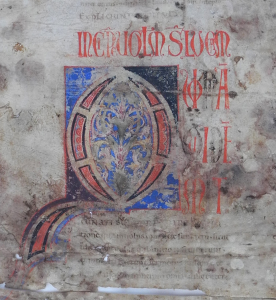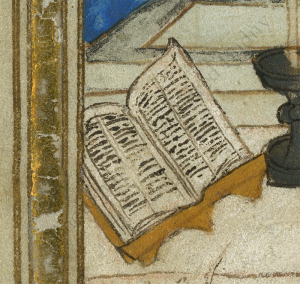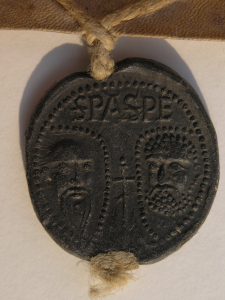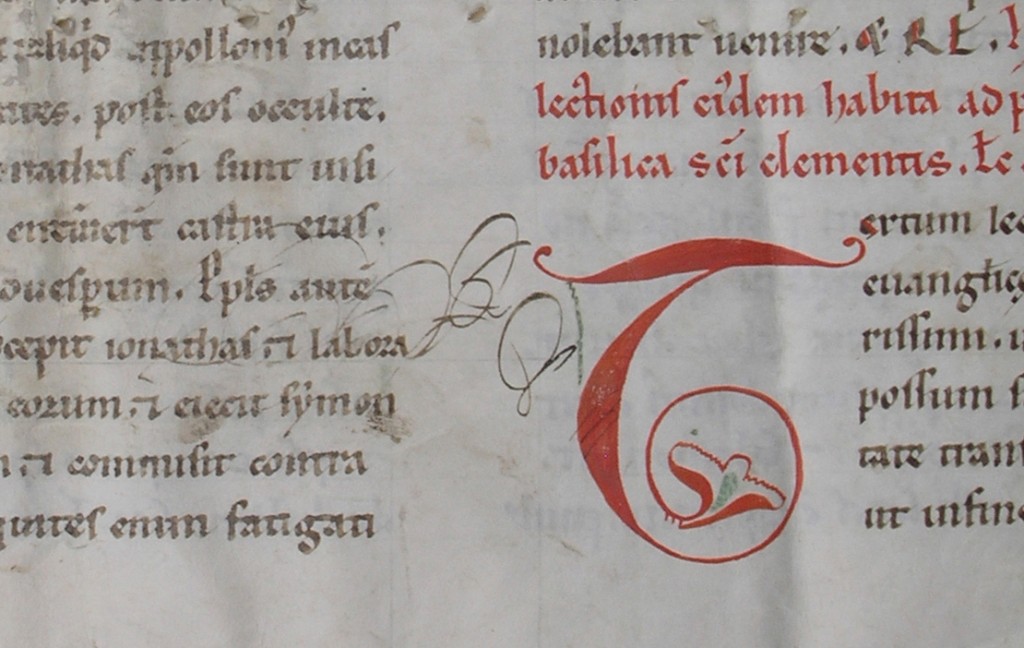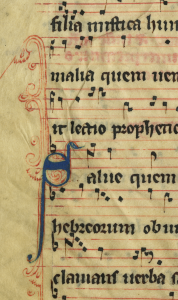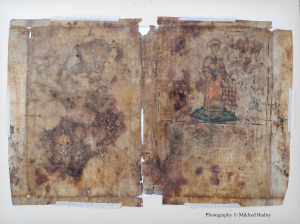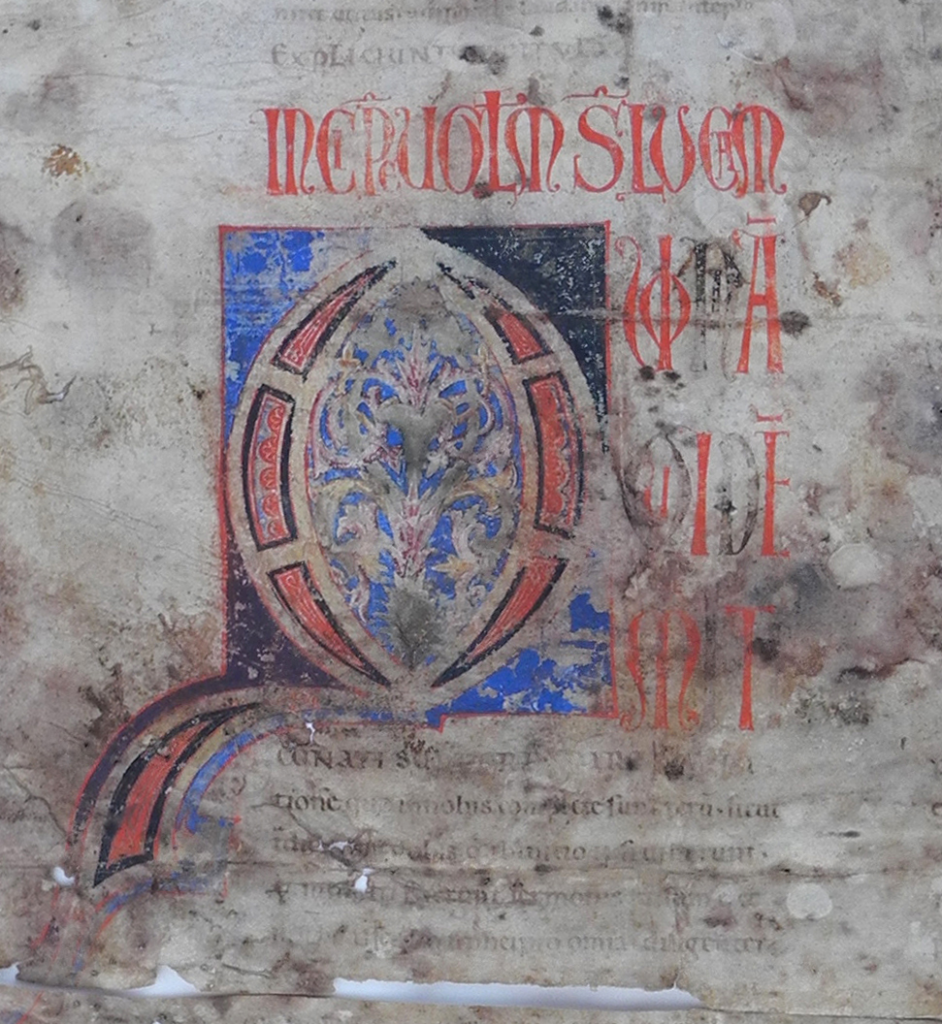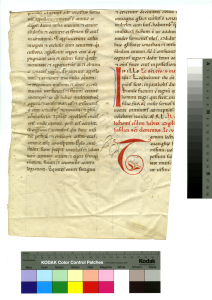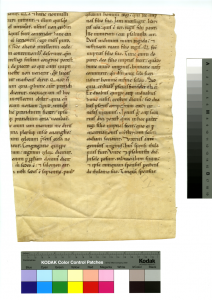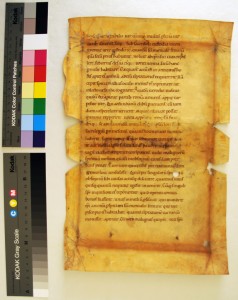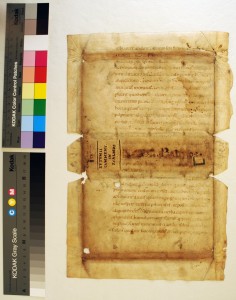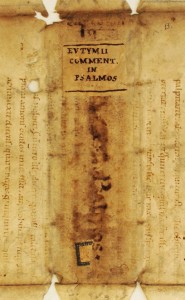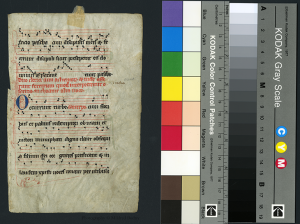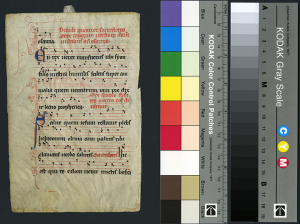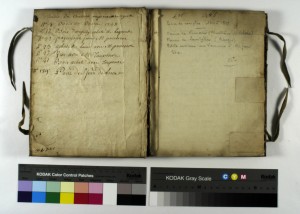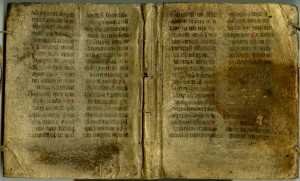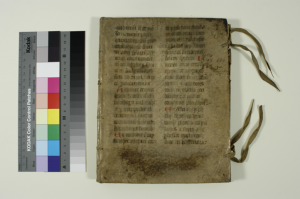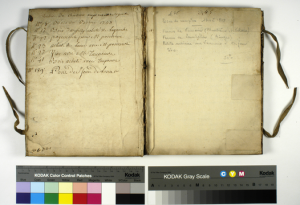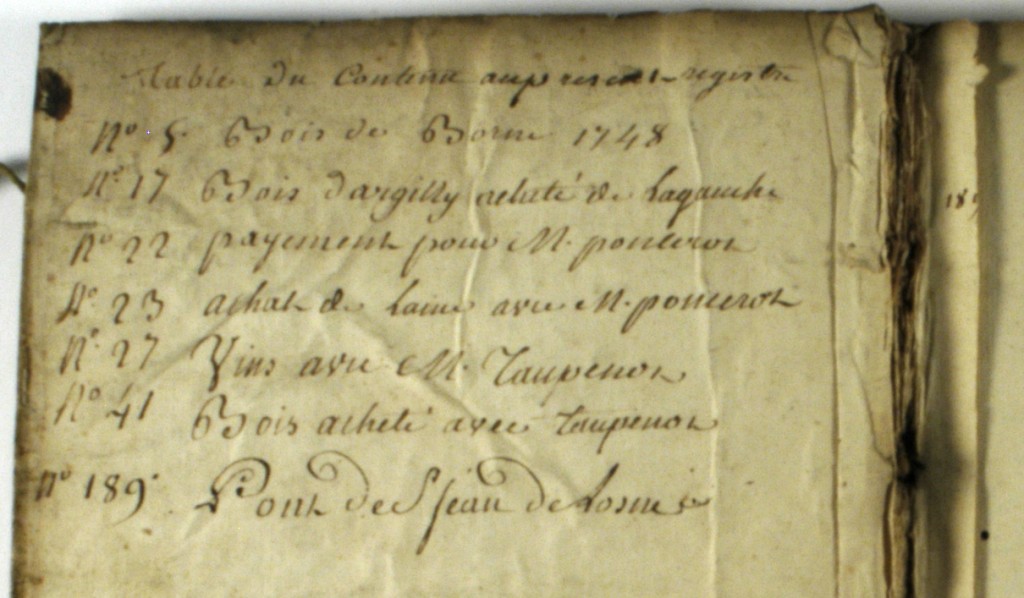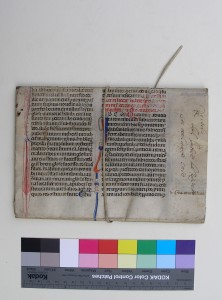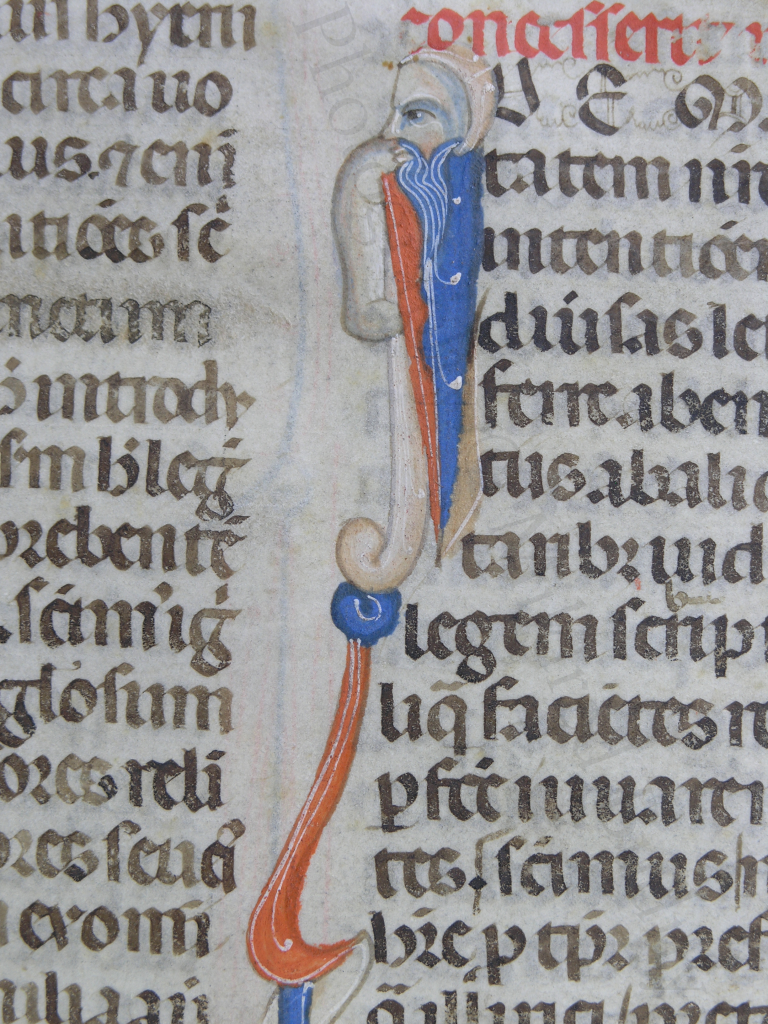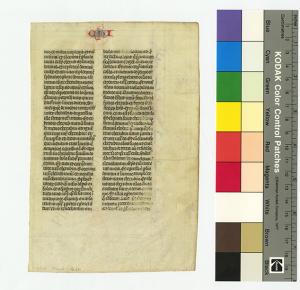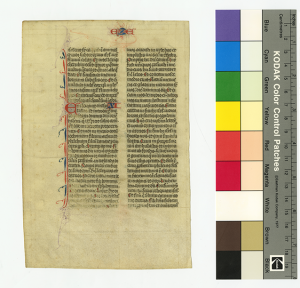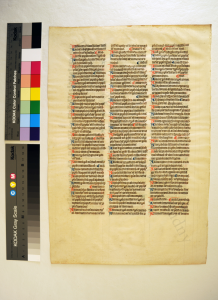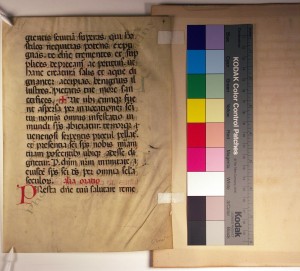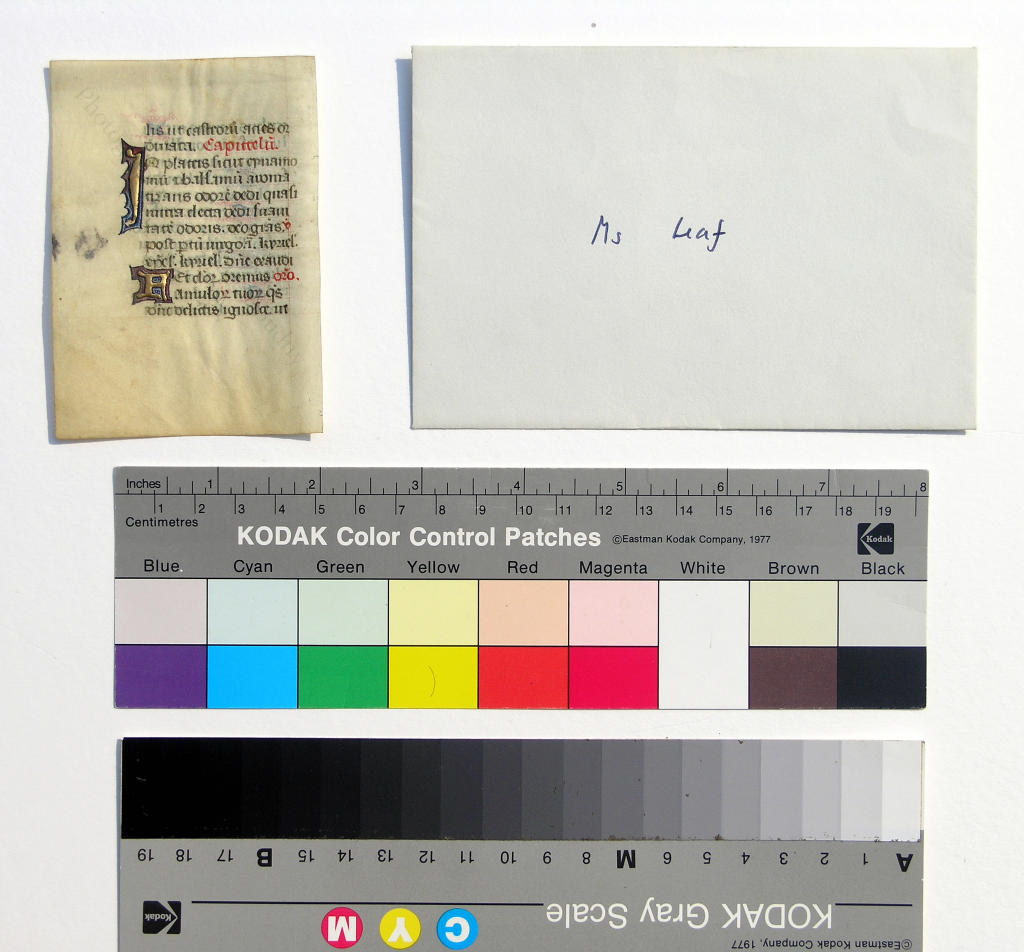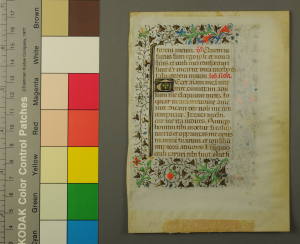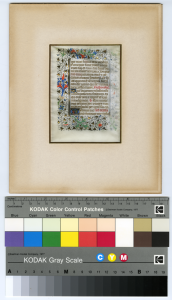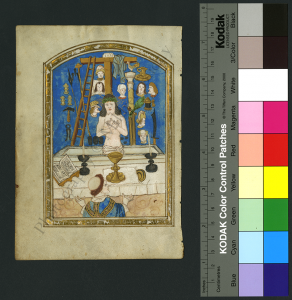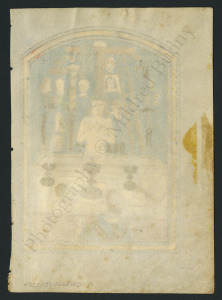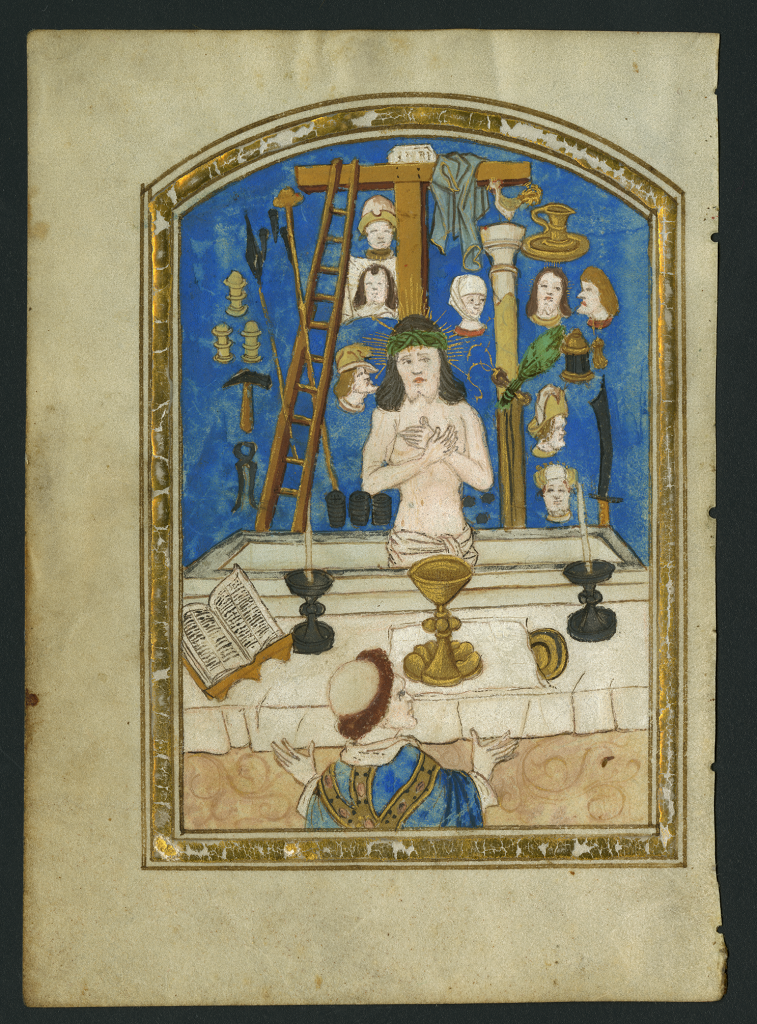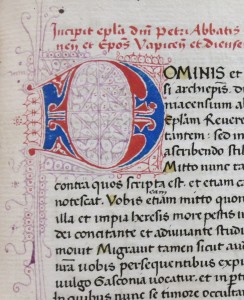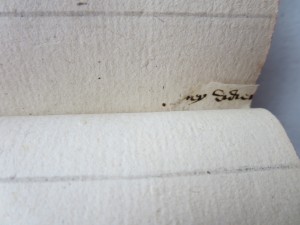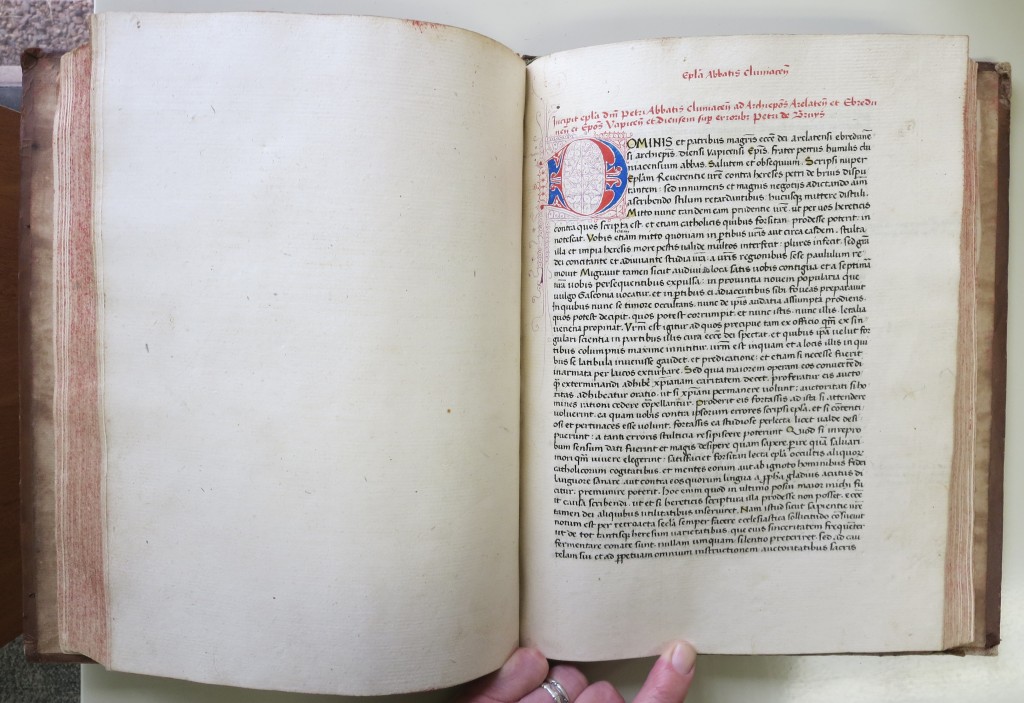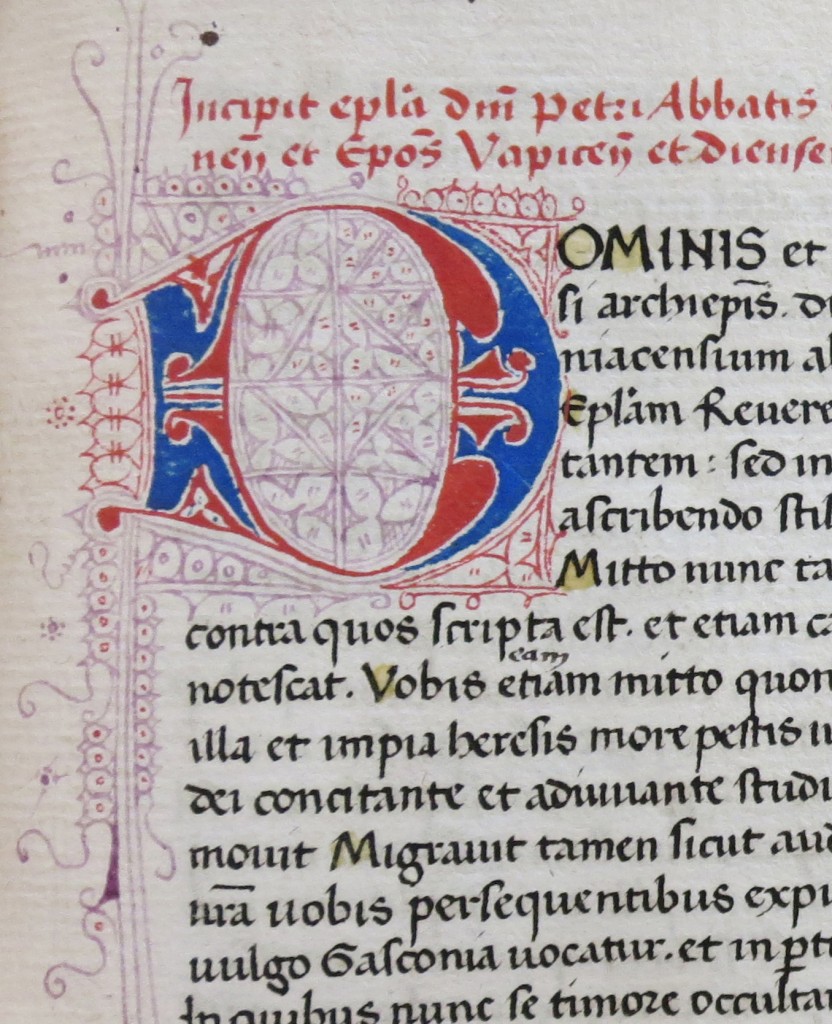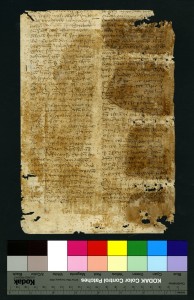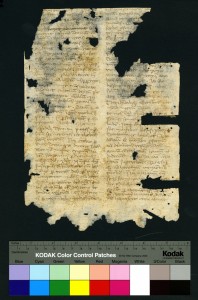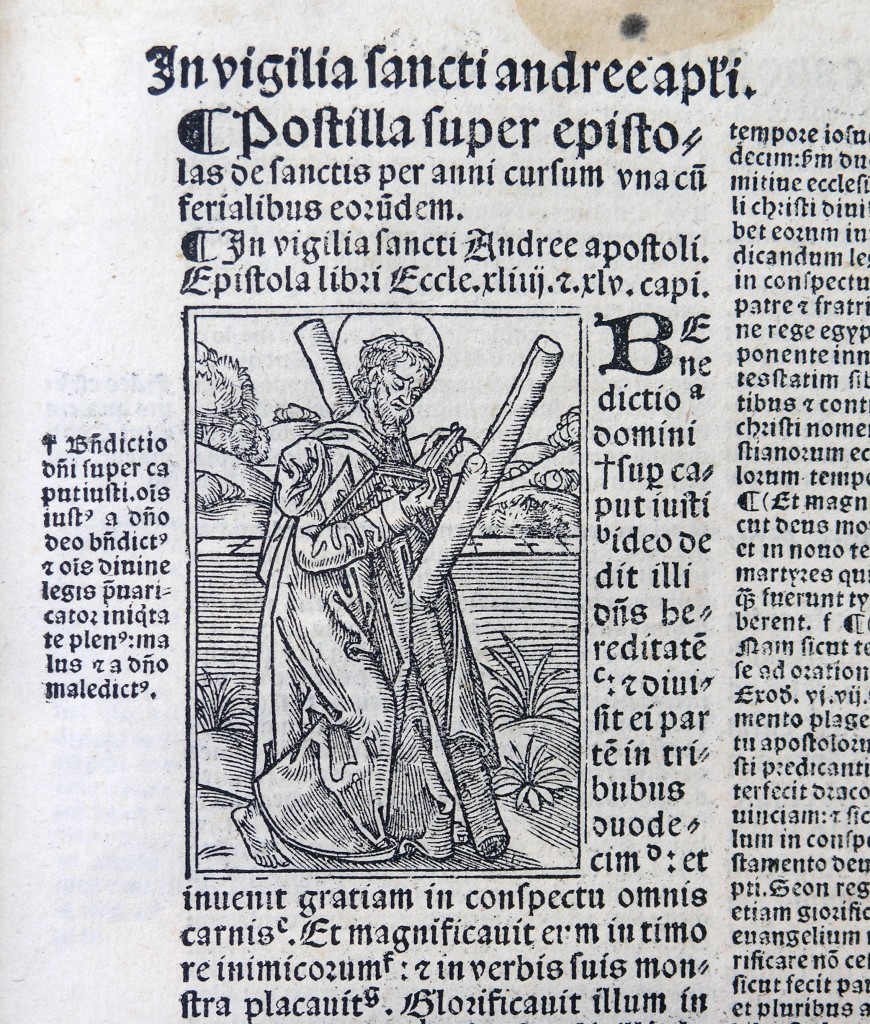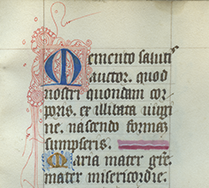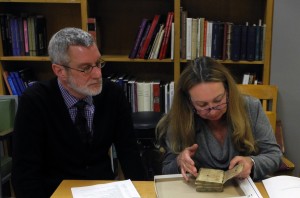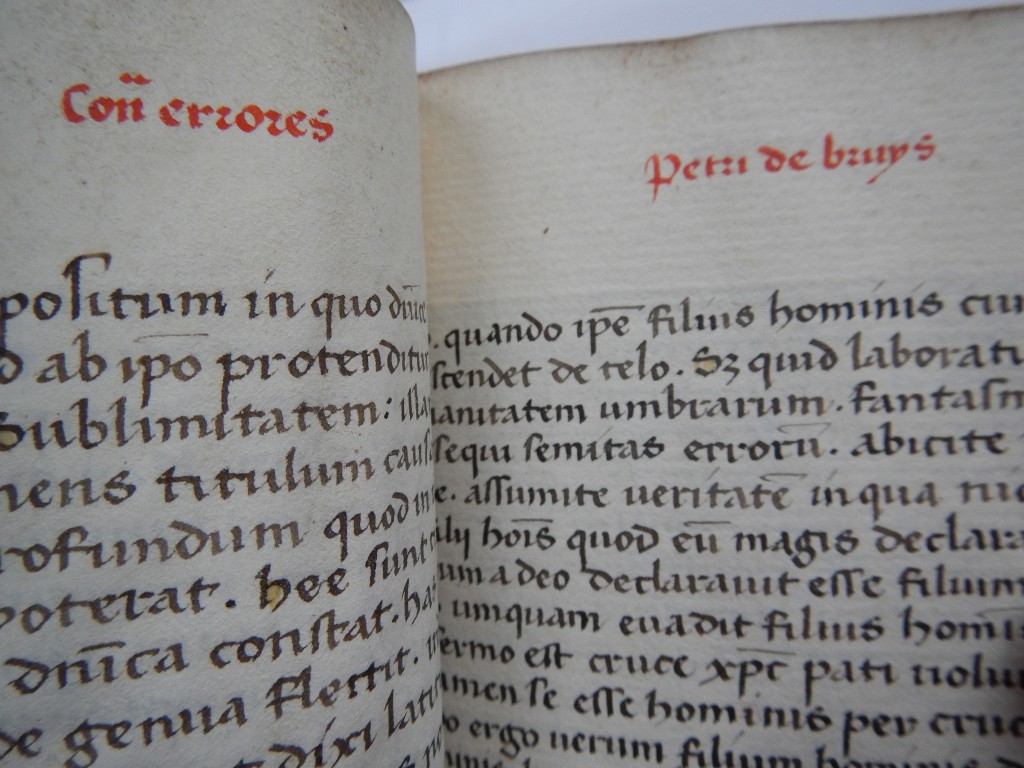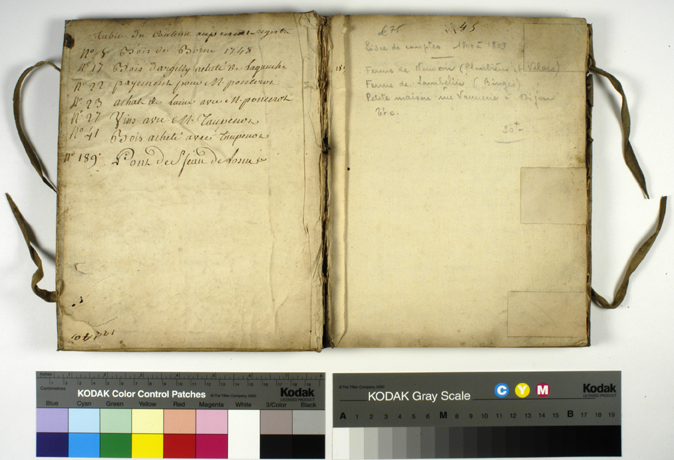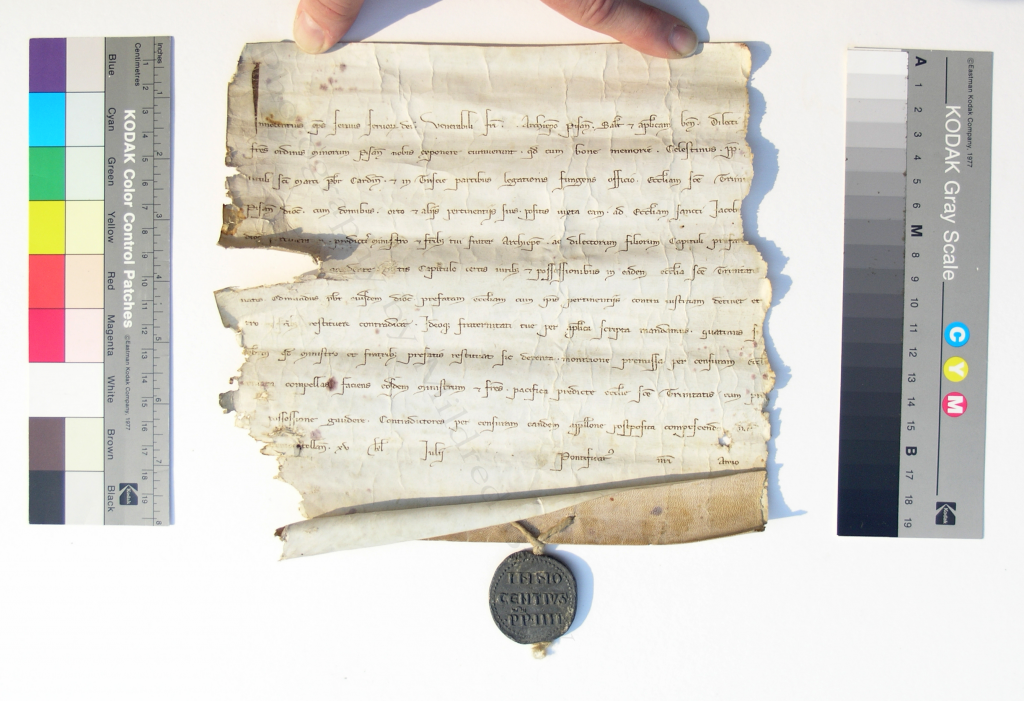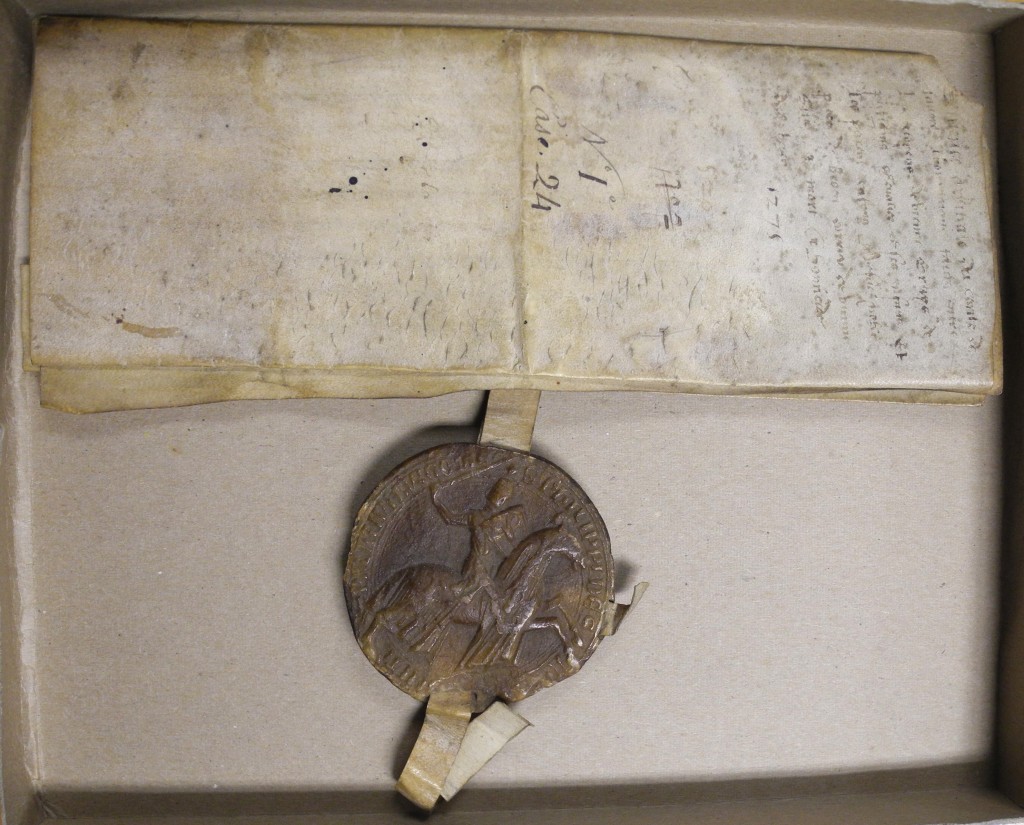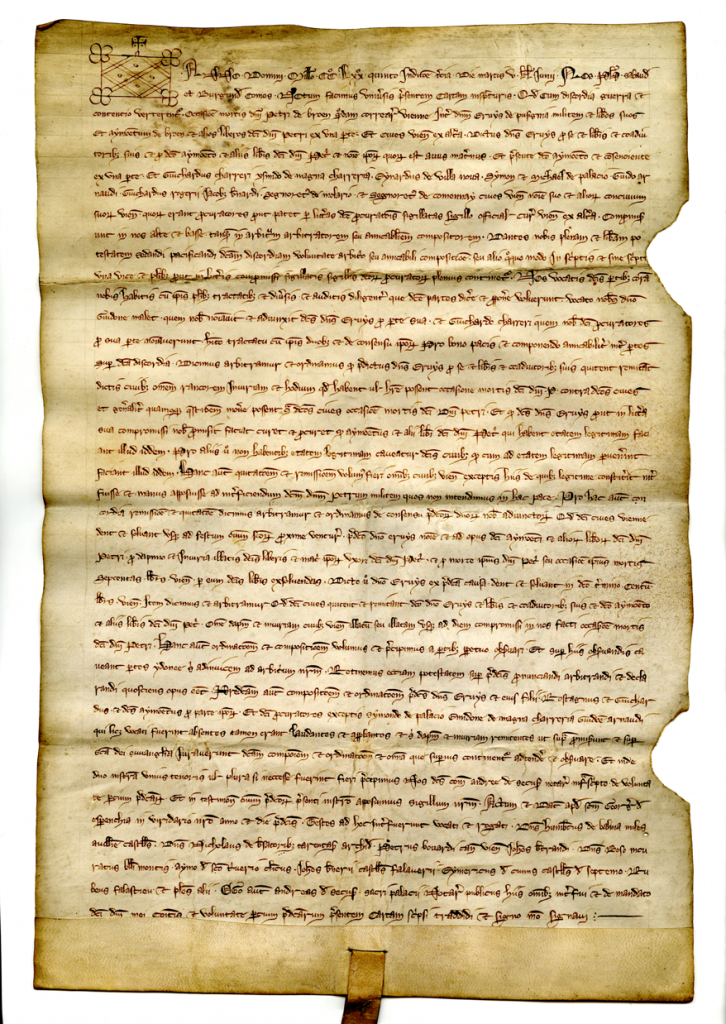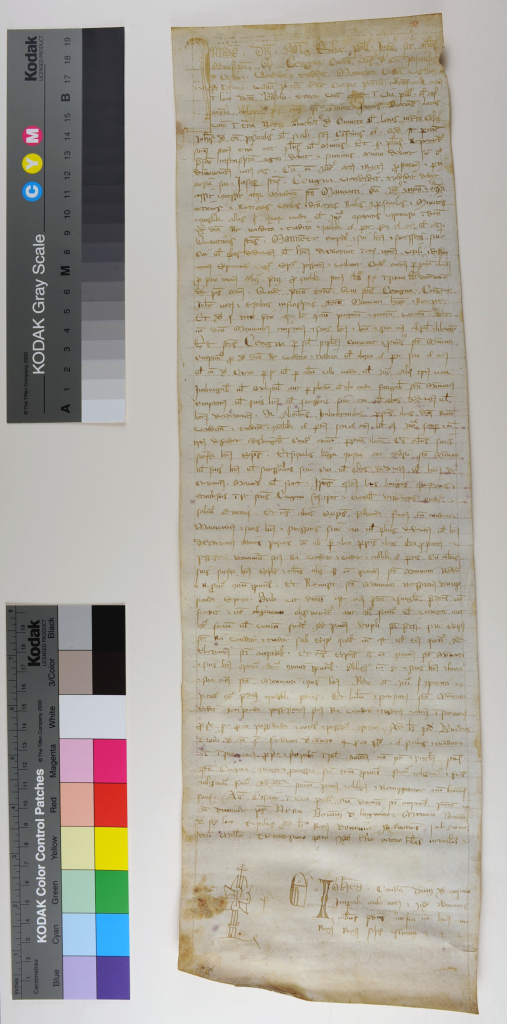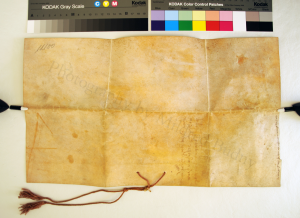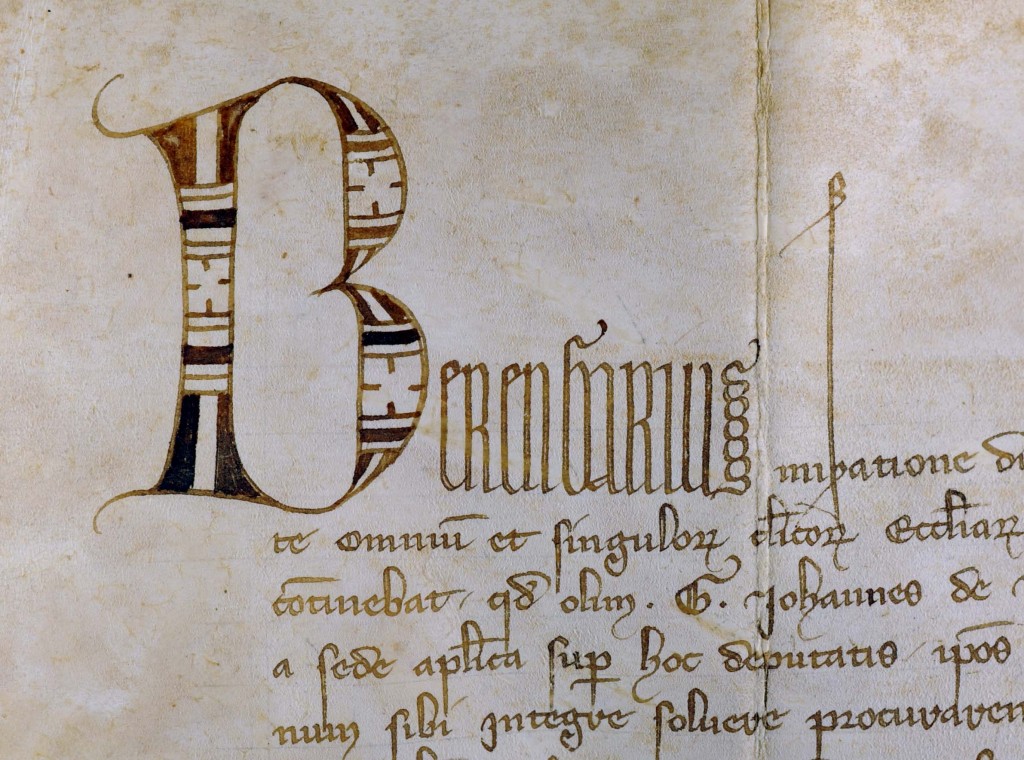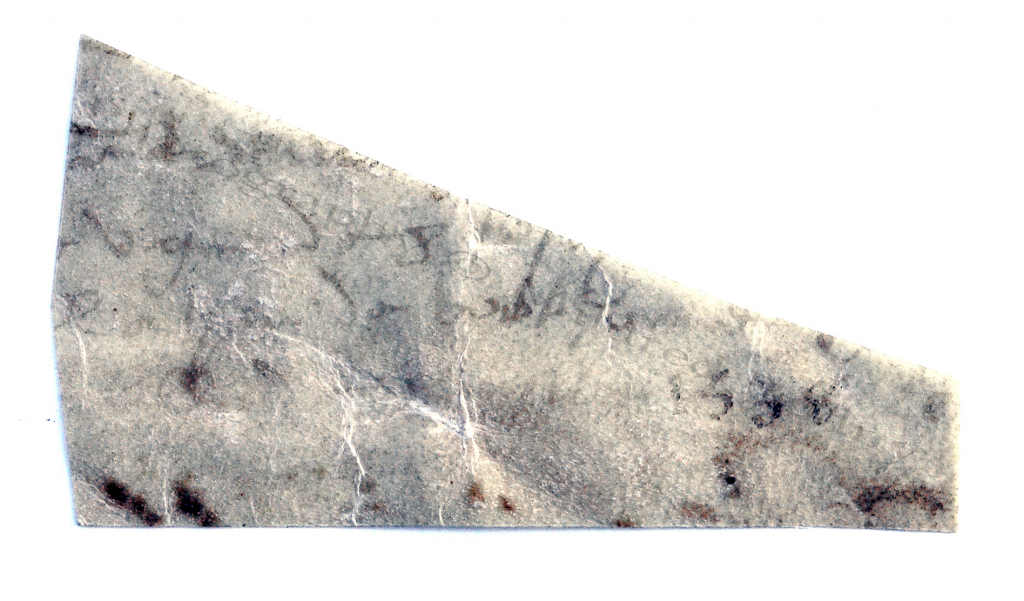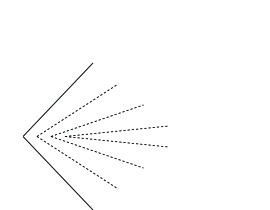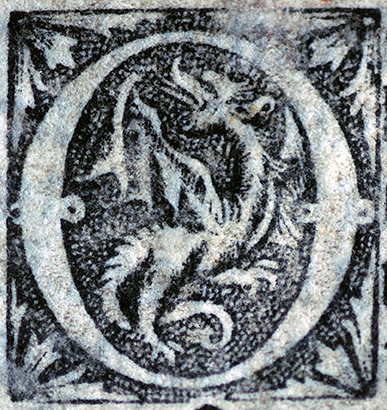Illustrated Handlist of
Medieval and Early Modern
Manuscripts, Documents, and Printed Materials
Conservation, Photography, and Research
Discoveries Included
by Mildred Budny
[First published on 17 April, 2015, with updates]
As we unveil research results for an extended study of a single owner’s group (an “assembly” rather than a “collection” as such) of medieval and early modern manuscripts, documents, and printed materials, here is an illustrated list of the contents of their Handlist. Details of the materials, their conservation, and cumulative research results are being reported, in stages, on other parts of this website, as well as elsewhere in printed form, including an illustrated Album.
Reports of some Items appear, among reports from other collections, in our blog on Manuscript Studies (2014–). Grouped by categories of materials, they are cited in its Contents List.
Here, in overview, we include details of the sources and dates of acquisition, where these are known or remembered. It is worth recording that those details have emerged more clearly through several years’ of conversations, questions, and re-considerations, in consultation with their owner as the research work gained refinements about the materials, their nature, and their patterns of transmission across centuries.
This Illustrated Handlist is the work of our Director Mildred Budny. You could learn more about her work, activities, and interests, and view her Curriculum Vitae on Mildred Budny: Her Page.
You might like to know that the unfolding publication of this Handlist — with summaries in this Post and detailed Reports of individual Items elsewhere (including in our blog) — stands within the tradition of Mildred Budny’s close studies of manuscripts and other written materials. Notable examples include
- the Ph.D. dissertation
— available freely online here - its summary in an early post for our blog as
The “Foundling Hospital” for Manuscript Fragments - the Manuscript Studies blogposts
- the Illustrated Catalogue
— now available through the Research Group with a special Promotional Offer
Photography © Mildred Budny
High-quality versions of the photographs, without watermarks, may be obtained.
In some cases a charge may pertain to supplying images.
Please send your requests for images and permission to reproduce them to director@manuscriptevidence.org.
The Handlist and Its Groups
The List subdivides into parts and sub-sections according to the writing medium or media (parchment, paper, composite, etc), type of text (manuscript or fragment thereof, document, printed material), and language (Latin and/or vernacular). Within each part or section, the sequence is more-or-less chronological, insofar as dating criteria are available. The divisions follow these groupings:
Part I. Manuscripts and Fragments
(In some cases combined or formerly combined with Items in other Parts)
I.A. Single Leaves and Single Bifolia on Vellum
I.B. Larger Portions of Single Manuscripts
(Remnants, Complete, or Nearly Complete)
on Vellum, Paper, or Both
Part II. Documents on Vellum
I.A. In Latin (Some with Vernacular Elements)
II.B. In Vernacular
Part III. Early Printed Materials
III.A. On Vellum
III.B. On Paper
Some of these items have, or comprise(d), bindings of one sort or another.
*****
Sources and Provenance
The sources, methods, and dates for their acquisition are sometimes known, or partly known. This information, insofar as available, is recorded for the different items.
In addition to the composite items, combining several forms of materials, dates, and genres in a single unit, several sources yielded more than one item, as with the purchases on a single day from one bookseller in Florence, Italy, on 20 June 1972 (Handlist Numbers 2, 7, 18, and 20; the fifth item is not yet identified) and the acquisition over time by several methods from one source in the Département of Saône-et-Loire, France, from about 1999 onward. The date-range for some acquisitions can be narrowed through a combination of recollections, photography, and research.
Distinct benefits from the process of working with the materials over a number of years and discussing them at various times with the Owner include the corrections and refinements in the recollections and reports of their Sources, whence, where, when, and from whom they came into the assemblage.
Reports and Records of Items in the Handlist
Some items are recorded in print briefly in
Cited here as: Faye and Bond, Supplement to the Census of Medieval and Renaissance Manuscripts (1962), with relevant page(s).
Some items formerly belonged to manuscripts dispersed in fragments by Otto F. Ege (1888–1951). Their identification initially by Mildred Budny entitles them to join the growing recognition of dispersed remnants from Ege’s manuscripts. Those manuscripts, as recognized so far, are listed in the
- “Handlist of Manuscripts and Fragments Collected or Sold by Otto F. Ege” assembled by Scott J. Gwara, Otto Ege’s Manuscripts: A Study of Ege’s Manuscript Collections, Portfolios, and Retail Trade, with a Comprehensive Handlist of Manuscripts Collected or Sold (2013), Appendix X (pages 113–201).
Cited here as: Gwara, Otto Ege’s Manuscripts, (2013), with relevant page(s).
Reports of some items of the Illustrated Handlist appear on this website, as cited individually below. They include the first reproductions, and the first reproductions in color, for many of the items.
Display and Teaching Tools
From the beginning of the work of photography, conservation, and research, the intentions for the work have explicitly included the presentation by Mildred Budny of exhibitions, seminars, demonstrations, and classes focusing upon these materials and the methods of studying them and their relatives, based upon in-depth knowledge accumulated over time. These aims were expressed, in part, as a token form of augmenting compensation for the work, mostly carried out on a volunteer basis, with some partial reimbursement over the years for the conservation and photographic materials.
These intentions for presentations over the materials or elsewhere have resulted in such events as the Research Group’s
- 2013 Symposium on “Identity & Authenticity”, with a Paper on Handlist 16; its Abstract here
- 2014 Seminar on “Manuscripts & Their Photographs”, with presentations considering in particular Handlist Numbers 16, 17, and 19
- 2016 Symposium on “Words & Deeds”, with a brief report on Handlist 17; its Abstract here
Reports of items in the Handlist appear in the Research Group’s blog on Manuscript Studies.
We welcome invitations to discuss these materials and the benefits of long-term acquaintance with a body of diverse materials, sustained and enhanced by an integrated approach to manuscript and related studies. We would appreciate citation of these research reports when publishing your own work on the materials.
Please let us know of further discoveries about the materials. Happy to join the conversation, all in the interests of furthering knowledge.
*****
Part I. Manuscripts and Fragments
In some cases, these are combined or formerly combined with Items in other Parts of the Handlist.
I.A. Single Leaves or Bifolia in Latin on Vellum
Handlist 1
The Opening of Luke from a Romanesque Giant Italian Bible
Fragments of a large-format leaf (severed into 2 pieces for its early modern reuse)
from the opening leaf for the Gospel of Luke,
with later ’embellishments’ for the front cover in its reuse in the binding of some other contents (unknown)
Luke Chapter List, chapter 21 (nec credunt discipuli) – Luke 1:1–24 (maria inuen-) on recto
Text on verso too much abraded to ascertain its concluding span
Present Measurements: Circa 510 × 350 mm
(now in 2 interlocking pieces severed by knifepoint unevenly across the midsection, probably during the preparation for reuse)
< written area circa 394 × 200 mm >
Double columns of 45 lines in revived Caroline minuscule in light brown ink
with embellishments.
Opening title in ornate 3- and 4-line Decorated Capitals alternating in red and now-blackened pigments
with 1 of its lines above and the short 3 next lines to the left of the opening initial
Polychrome 10-line inset Decorated initial Q for Quoniam in red, blue, green, and now-blackened pigments
with panels of geometric and foliate ornament
Section initials in red in different sizes:
4- or 3-line initials to the left of the columns or 1-line initials within them
Italy, probably Rome, 11th century
Reused formerly as a cover or wrapper for some other volume (now lost),
with an added illustration, probably 15th-century, for its front cover:
Framed, full-length figure of St. Lawrence
holding a gridiron and accompanied by 3 identical coats of arms
Damaged by wear, exposure, and mold
Acquired by purchase as a detached leaf in the Spring of 1951 at an auction (unspecified) in Florence, Italy
Presented as a ‘travel gift’ to the purchaser’s brother, who had the leaf mounted in a double-sided gilded wooden frame.
The leaf was removed from the frame and its mats in 2014 for preservation on its own, in its 2 parts in separate melanex envelopes.
The leaf is recorded briefly, with a description supplied by its purchaser, for the brother’s collection, in
- Faye and Bond, Supplement to the Census of Medieval and Renaissance Manuscripts in the United States and Canada (1962), page 284 (column 2, top, number 1).
Now we unveil the first published and color images from the leaf.
Report here: The Opening of Luke from an Italian Romanesque Giant Bible
*****
Handlist 2
Part-Leaf from a Large-Format Lectionary
Fragmentary leaf probably from a large-format Lectionary
Parts of I Maccabees 10 and
the Homily XXXVIII on the Gospels by Gregory the Great
Reduced to the lower part of the former leaf for reuse as a wrapper for unknown materials
Circa 334 × 243 mm
< written area now circa 234 × 222 mm >
Double columns now of 25 lines (trimmed down at the top and side) in revived Carolingian Minuscule in brown ink
with embellishments in red and green pigments in column b on the recto
Opening and closing titles in 1 or 2 lines in red pigment
Enlarged inset 6-line initials in red pigment (I for In and T for Tunc),
plus foliate ornament in green in the T
Probably Italy, perhaps Northern Italy, circa 1175
Acquired as a separate leaf by purchase from the Libreria Leo S. Olschki in Florence, Italy, for US $10 on 20 June 1972,
along with 4 other items, including Handlist Numbers 7, 18, and 20; the 5th item is not yet identified
Report here: Part-Leaf from a Large-Format Lectionary
*****
Handlist 3
Leaf from the Dialogues of Pope Gregory the Great
Reused for Binding Euthymius Zigabenus On the Psalms
Part of Book III, chapter 7 (on Andreas, Bishop of Fondi/Fundi):
Sections 2 (namque uenerabilis uir) – 8 (uel quae in conuentu)
Circa 357 × 237 mm
< written area circa 266 × 133 mm >
Single column of 28 lines in revived Caroline minuscule
without embellishments
Germany, circa 1175
Reused formerly as the protective vellum cover for the binding of a copy of
Euthymius Zigabenus’s Commentary on the Psalms
(now lost or preserved elsewhere in a location unknown),
with remnants of its titles on the spine of the cover
The set of titles on the outside of the spine of the cover (the original verso of the leaf) remain in place, albeit abraded and fragmented, as both a pasted paper label (‘horizontal’) and an ink inscription in Capitals (‘vertical’, with the tops of the letters toward the ‘front cover’).
Acquired, probably by purchase, in France in the past 15 years or so, but before 2007 when I first saw and photographed the leaf.
Report here: A Leaf from Gregory’s Dialogues Reused to Bind Euthymius
On Gregory’s Dialogues and their transmission, see the Report of ongoing-discoveries of leaves from another dismembered manuscript of the Dialogues (and other texts): A New Leaf from “Otto Ege Manuscript 41”.
*****
Handlist 4
Processional for Palm Sunday
for the Use of Nuns
(from “Otto Ege Manuscript 8”)
From a Processional (or ‘Gradual’) produced in England circa 1275 for the use of nuns
Circa 185 × 123 mm < written area circa 140 × 90 mm >
Single columns of 9 lines of text in Gothic Textura
accompanied by Square musical notation on 4-line staves
with polychrome embellishments:
Rubricated directions in red pigment
Enlarged and decorated inset 1-line initials (that is, including the text + stave) in blue pigment,
with filling for the initial and marginal extensions from it in red pigment,
sometimes forming foliate or animated terminals
Acquired somehow by gift (unremembered), already framed, probably in the United States, perhaps after the preparation of the Supplement to the Census printed in 1962 (pages 283–284), as that record does not include it — although another item in this Handlist, unreported in the Census, was a wedding gift in 1959 in a gilt frame (now removed): Handlist 12.
Detached Leaf from Otto Ege Manuscript 8 (Gwara, Handlist 4),
also known as The Wilton Processional
Report here: A New Leaf from ‘Otto Ege Manuscript 8’
See also the succession of articles (2016), cited in that Report, by Alison Altstatt on “The Wilton Processional”
Update on 18 June 2020: See Some Leaves in Set 1 of Ege’s FOL Portfolio.
*****
Handlist 5
Paper Notebook in French
Covered with a Reused Medium-Format Psalter Bifolium in Latin
Acquired, probably by purchase, in France as a composite unit between circa 1999 and 2007 when I first saw and photographed the ensemble
Report here: Cover-Up
Part A
Bifolium (folios ‘I’/’II’) from a Medium-Format Latin Psalter or Breviary
Parts of Psalms 77 on Leaf I and 88 on Leaf II
Visible span circa 380 × 226 mm, plus hidden turn-ins on all sides
< written area circa 160 × 124 mm >
Double columns of 19 lines
with inset 1-line initials in red pigment
Perhaps France, 13th or early 14th century
Reused, and still in situ, as the cover for the pasteboards of an early modern paper notebook (partly despoiled) with accounts in French = Part B
Report here: Cover-Up
Part B
Paper Notebook for ‘Recettes’ Etc.
Notebook now of 99 leaves (with some first leaves removed),
plus paper pastedowns at front and back,
employing the medieval vellum bifolium of Part A
as the ‘leather’ covering for the pasteboards of its binding,
plus two pairs of added leather ties (18th-century)
Various texts in sections written in ink in the late 18th – early 19th centuries,
with some blank leaves and with a set of entries in pencil by a single bookseller’s hand in the late 20th or early 21st century on folio ‘1’r (as counted at present)
Notebook circa 226 × 178 × 27 mm
< written area variable >
‘Table du contenu’ on front endpaper for items numbered [on pages] 8, 17, 22, 23, 27, 189
Seller’s inventory in pencil on first page with an incomplete ‘Liste de comptes 180_[?] á 1809′
France, mid-18th century and later, in or relating to Dijon and its region
Report here: Cover-Up
*****
Handlist 6
[Place-Holder Locating Handlist 16, Part A]
Note: This Placeholder locates the approximate location in the chronological sequence
for the Leaves on Paper from a Single Manuscript in
Handlist 16, Part A (below):
Fragments of the Vitae Patrum,
including some textually consecutive leaves,
recovered from their reuse in pasted groups
(along with some printer’s scraps)
as the front and back boards for a 1527 printed book
(Handlist 16, Parts B and C)
*****
Handlist 7
Large-Format Leaf from Justinian’s Novels
Reused as a Wrapper
Reused, with an added vellum tie,
as a folder for other materials (now lost), and preserved in the folder form
Part of Justinian’s Novellae Constitutiones,
Novel CLIX [159], Caput II (humilitatis cognitionem) ‒ II (end),
followed by Novel CXXXIV [134],
from its Preface to near the end of Caput III
(either within or with praedictarum, partly hidden under the pasted turn-in of the wrapper)
With some sections of Commentary added in the margins of the inside of the wrapper
Circa 406 × 217 mm as the opened wrapper, with its turn-ins still in partly pasted down
Counting the turn-ins, the maximum surviving extent of the leaf is circa 485 × 231 mm,
with its margins more-or-less intact (apart from the gutter and its original stitching line)
<written area circa 254 ×155 mm, with the columns intact >
Double columns of 46 lines
with polychrome embellishments
Running titles in letters alternately in red or blue pigment
Partly inset polychrome Initial I for Idem painted in blue, white, and other pigments
embellished with a bearded male human head
and geometric and foliate extensions and terminals
Other animated embellishments for a passage or commentary
form outlined designs in ink
with a hand holding a club and with a hooded human head facing left in profile
Added sketch of a bearded human head in ink alongside a passage of text
Bologna, circa 1300
Acquired by purchase from the Libreria Leo S. Olschki in Florence, Italy, for US $10 on 20 June 1972,
along with 4 other items, including Handlist Numbers 2, 18, and 20 (the 5th item is not yet identified)
Report here: It’s a Wrap
*****
Handlist 8
Part of Ezekiel 10–11
from a 32-line French Vulgate Pocket Bible
(= “Otto Ege Manuscript 61”)
Old Testament Book of Ezekiel 10:3
([in manu eius] /uir et nubes impleuit) – 11:15 (et omnis domus / [Israhel . . . ])
Circa 186 × 126 mm
< written area circa 119 × 81 mm >
Double columns of 32 lines, with embellishments and running titles
The ‘Ege’ pencil inscription ‘1310 French Bible’ stands at the bottom of the recto
Formerly part of Ege Manuscript 61 (Gwara, Handlist 61)
Probably Southern France, circa 1325
Acquired at an unknown time and place, perhaps or presumably after the owner’s report for the 1962 Supplement to the Census by Di Ricci and Wilson
Report: A New Leaf from ‘Otto Ege Manuscript 61’
Update: More Discoveries for ‘Otto Ege Manuscript 61’
*****
Handlist 9
Part of the AL–AN-Groups
in the Interpretationes Hebraicorum Nominum
from a Lectern Bible
(= “Otto Ege Manuscript 14”)
Part of the ‘List of Hebrew Names’
in the partly alphabetized Version beginning Aaz Apprehendens
(or in a Variant thereof)
from a large-format Lectern Bible now dispersed in various collections
Alchath – Ananias from the partly alphabetized A-Group
Circa 312 × 212 mm
<written area circa 225 × 157 mm >
Triple columns of 50 lines written in Gothic bookhand
An ‘Ege’ pencil inscription stands in a spaced single line at the bottom of the recto:
‘$2.__ French Bible 1300 – List of Hebrew Names’
Formerly part of Ege Manuscript 14 (Gwara, Handlist 61)
Flanders or Northern France, circa 1325
The leaf is recorded briefly, with a description supplied by its owner, in
C.U. Faye and W.H. Bond, Supplement to the Census [by Seymour de Ricci] of Medieval and Renaissance Manuscripts in the United States and Canada (1962), page 284, number 4.
Acquired by purchase for $2.00 (price on the leaf) at the gift shop of the Cleveland Museum of Art in late summer of 1956, on the way across country for the start of the next academic year.
Note: My earlier reports of the date of acquisition (‘1951’) require revision here, as the cumulative research on the group of materials progresses and the owner’s recollections of sources for the materials have deepened in scope.
Report: A New Leaf from ‘Otto Ege Manuscript 14’
Updates:
- 2016 Symposium on Words & Deeds
- 2016 Symposium Program Report
- More Discoveries for ‘Otto Ege Manuscript 14’
- Updates for Some ‘Otto Ege Manuscripts’
- Some Leaves in Set 1 of Ege’s FOL Portfolio (18 June 2020)
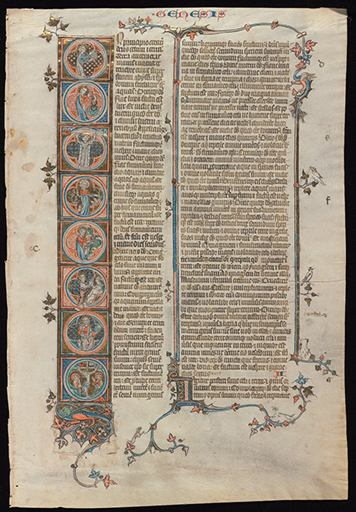
First page of Genesis from ‘Otto Ege MS 14’. Otto Ege Collection, Beinecke Manuscript and Rare Book Library, Yale University. Reproduced by permission.
*****
Handlist 10
Folio 4 from an ‘Italian Missal’
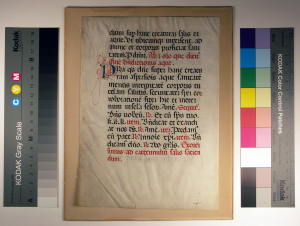
Handlist 10: Original Verso, still on its Ege-style mat, positioned as the front-facing page for the viewer
Exorcisms and Blessings of Salt and Water
The texts extend from
[qui inimici ru-]/gientis seuitiam superas . . . Escorcisimus ad catecuminum salis faciendum. /
Circa 222 × 158 mm
<written area circa 150 × 104 mm>
Single columns of 18 lines, starting below the top ruled line
(From an Ege Manuscript,
although not from one as yet identified in Scott Gwara’s Handlist of such manuscripts?)
Italy? Southern France? circa 1400
Acquired by an unknown route, perhaps by gift already framed, before the preparation of the description for the Census printed in 1962
The leaf is recorded briefly, with a description supplied by its owner, in Faye and Bond, Supplement to the Census of Medieval and Renaissance Manuscripts in the United States and Canada (1962), page 284, number 5.
Now see Folio 4 with Latin Blessings for Holy Water and an Exorcism for Salt.
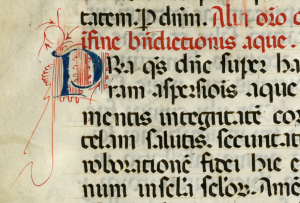
Private Collection, Single Leaf from a Latin Missal. Folio 4r, Detail. Reproduced by permission.
*****
Handlist 11
Part of the Hours of the Virgin
from a Little Book of Hours
The text on the leaf extends from
Psalm 127:3: ([la-]/teribus . . . Israel) –
Prayer: Famulorum tuorum . . . ut / [qui]
Circa 76 × 54 mm
< written area circa 40 × 36 mm >
Single column of 12 lines in rotunda script
Southern France, Italy, or Spain (?) circa 1400 or later
Acquired at an unknown date, unframed, and from an unremembered source; perhaps or presumably after the Owner’s report to the 1962 Supplement: Faye and Bond, Supplement to the Census of Medieval and Renaissance Manuscripts (1962), at pages 283–284.
Report here: Leaf from a Tiny Book of Hours
*****
Handlist 12
Part of the Office of the Dead
from a 15th-Century Book of Hours
The text [as recorded here at Vespers] extends from within the
Responsorum [. . . salva-] / -torem meum
to within
Lectio tertia. Manus tue fecerunt me et plas– / [-mauerunt me . . . ]
Circa 135 mm × 100 mm
< written area circa 66 × 50 mm >
Single column of 17 lines
Vertical banded gold bar at the left of each column,
within the angular C-shaped open-sided frame formed of foliate and floral ornament,
including prominent monochrome or polychrome painted sprays
Pencil inscription, partly hidden by masking tape, beginning ’10 —’ at bottom of the recto,
presumably a price followed by some further information about the leaf as an item for sale
Flanders (probably Bruges or Antwerp), circa 1470
Acquired as a wedding gift, already mounted within a double-sided gilt wooden frame, in late 1959 from Josephine Edmonds Case (1933—2010). Her source for the gifted leaf is unknown, but some clues might reside under the masking tape following the numeral or price in an unspecified currency, rounded up to the full unit (say, in dollars or pounds sterling).
The frame, with a pair of mats and glass panes, presented a back-to-back view of the leaf, cropped to hide the exterior of the margins and to cover the masking tape which affixed the recto to the second mat. The leaf was removed from the frame and its mat in 2008, with gentle conservation and remounting within a melanex envelope. The owner has retained the frame for another purpose.
Report here: A Leaf from the Office of the Dead
*****
Handlist 13
Frontispiece Illustration of the Mass of Saint Gregory
Detached leaf
From a late 15th-century prayerbook
Circa 164 × 118 mm
< frame circa 130 × 91 mm >
No text on recto; full-page framed illustration on verso
Probably from the Low Countries, circa 1480
Purchased in 1993 for $2,500 from Phillip J. Pirages’ Catalogue 24 (1992), item 20 (with uncropped black-and-white plate of the recto in full in Plate 5 top right), identified there as:
EASTERN FRANCE OR THE RHINELAND, Second half of the 15th century.
Another black-and-white plate, cropped, shows the illustration:
- Giles Constable, ‘The Ideal of the Imitation of Christ’, Three Studies in Medieval Religious and Social Thought (1995), plate 22, with an exposition on pages 228–230
The first reproductions in color of this leaf, or any details from it, appear on the website of the Research Group on Manuscript Evidence: for example, in that Report (published in 2014) and in the revised version (2015) of the Style Manifesto of the Research Group.
Report here: The Mass of Saint Gregory Illustrated
*****
Handlist 14
[Awaiting]
*****
I.B. Larger Portions of Manuscripts
(Complete or Remnants)
on Vellum, Paper, or Both
Handlist 15
Composite 15th-Century Volume in Latin
from Le Parc Abbey
Part A and Part B represent separate manuscripts
made apparently at the Abbey
and combined within the 18th-century binding (Part C)
of the Premonstratesian Abbey of Parc, near Louvain
Part C
Post-Medieval Binding of Le Parc Abbey
with a set of Paper Pastedowns and Single Endleaf
at both the front and back
Bound as a single volume of 167 leaves (mostly unnumbered) on paper or vellum + single endpapers (folios ‘i’ at the front and ‘ii’ at the back) in an 18th-century binding characteristic of Le Parc Abbey, comprising cardboards covered with brown calf leather
Gilt back with title labels: ALBER./COMP./THEOLO. (Alberti Compendium Theologicae [Veritatis]), naming the first text in the ensemble
At their center, both covers carry the remnants of the effaced gold-tooled arms of Le Parc Abbey, Louvain — in a defacement characteristic for surviving books which formerly belonged to that abbey, carried its arms on their covers, and were prepared thus for their sale.
17th-century Le Parc Abbey pressmark I. theca V inscribed in ink on the front pastedown
along with the pasted-in Bookplates of Guy Ridley (1855–1947) and the present Owner
Part A
15th-Century Manuscript on Paper
with Reused Strips from a Cut-Up Manuscript
as Quire Supports
Folios 1–96
using 2 different types of paper and forms of arrangement in quires
Section 1
Folios 1–90 (Quires 1–7)
Watermark of a Double-headed Eagle,
not in Briquet, but somewhat like Charles Moïse Briquet, Les Filigraines (1907), Number 230 (20 recorded specimens dated between 1429–1450)
The inside folds of some quires were reinforced by strips cut from one or more manuscript materials. In some cases there remain marks of paste from lost strengthening strips, which were removed presumably in the 17th-or 18th-century rebinding.
Section 2
Folios 91–96 (Quire 8)
Watermark of a Drawn Bow-and-Arrow, not yet identified
Contents
Circa 275 × 205 mm
< ruled area circa 170 × 65 mm >
Double columns variously of 38–44 lines
Main text written by 3 hands
in Gothica hybrida currens and Gothica cursiva libraria
with rubrications and initials in red pigment
and a few elements of decoration
including geometric ornament in some initials and
marginal ink drawing of human heads
Indented areas for initials of Prologue, Books, and Sections
remain mostly unfilled
Added text written by 1 hand in Gothica cursiva currens
Main text:
Hugo Ripelin of Strasbourg (“Pseudo Albertus Magnus”), Compendium theologicae veritatis in 7 Books (folios 1r–91v), lacking an opening title, but ending with a concluding title which names the author as Albertus Magnus
= This widely circulated text is edited by Augusti Borgnet in Volume 34 [also here] (of 38 Volumes) in the Opera Omnia of Albertus Magnus (Paris, 1895). Some 300 manuscript copies are known.
Added text:
Humbert of Roman-sur-Isère, Epistola de tribus votis substantialibus religionis, Opening title and opening section, with the text adapted so as to apply to all religious persons and to remove the name and function of the author (folio 93ra1–10 plus 2-line opening title in the upper margin)
= The full, unadapted text is printed in Humbert of Romans, Opera de vita regulari, 2 volumes, edited by Joachim Joseph Berthier (Rome, 1888, reissued in Turin, 1956), I, pages 1–41
Part B
Manuscript on Paper and Vellum
Folios 96–167
(Quires 9–14, each mixing paper bifolios with 1 vellum bifolium in the middle of the quire)
Watermark of a Unicorn, rather close to Briquet (1907), Numbers 10015–10016 (with dated specimens of 1440–1450), not Number 10019 as reported by Fearns
Circa 275 × 205 mm
< ruled area circa 195 × 65 mm >
Single columns of 38–42 lines
Written by 1 hand in Gothica textualis libraria under Italian Humanistic influence
(a script typical of many 15th-century Le Parc manuscripts)
with rubrications in red
opening initials for the Prologue and the Text
in red and blue with pen-flourishing in red and purple
Wash of yellow pigment in the immediately following letters
and some section initials throughout the text
Contents
Peter the Venerable, Contra Petrobrusianos hereticos
= MS ‘C’ in the edition of this rare text by James Fearns
- Petrus Venerabilis, Contra Petrobrusianos hereticos, edited by J. Fearns, in the series Corpus Christianorum. Continuatio Medievalis, 10 (1968)
Provenance and Records
Ensemble purchased as a bound unit in 1956 from Bernard Quaritch, Manuscripts and Early Printed Books: Catalogue no. 735, lots 15[B] and 15[A] (page 4).
Lot 15A = Part II. Peter the Venerable, Epistola Super Erroribus Petri De Bruys [folios 97–167]
Lot 15B = Part I. Albertus Magnus, Compendium Theologicae Veritatis [folios 1–91 + 92–96]
Brief descriptions, prepared by the Owner, appear in the Faye and Bond, Supplement to the Census of Medieval and Renaissance Manuscripts (1962), page 284, numbers 3 and 2 (inverting the order of the texts in the manuscript, but corresponding with the Quaritch order)
The 2 different items are respectively
Descriptions also appear
- in print by James Fearns, ‘Introduction’, in Petri Venerabilis, ‘Contra Petrobrusianos Hereticos’, ed. James Fearns. Corpus Christianorum Continuatio Mediaevalis, 10 (1968), pages xi–xii (as Manuscript ‘C’ for that text) and page xiv
2. in 2 pages of typescript signed by Albert Derolez and dated ’20 Jan. 1995′, accompanying the volume
Preliminary Report here: Double Act: Manuscripts Combining Paper and Parchment
Detailed Report in Preparation
Update here: A Composite Volume from Le Parc Abbey
*****
I.B. Fragments from a Manuscript in Latin on Paper,
Associated with a Set of Early Modern Printed Components
Handlist 16
Postille of 1527
with Reused Paper Leaves
both in Manuscript (Medieval Vitae Patrum)
and in Print (Early Modern Glossary)
This item now comprises 3 separated Parts from a former composite volume,
acquired as a unit at an unremembered date and from an unremembered source
The detailed study of this composite structure yields on-going results.
Preliminary Report:
- “A New Fragment of the Vitas Patrum from the Covers of an Early Printed Postille:
An Early Case of Western Paper?”
presented at the 2013 Symposium on “Identity & Authenticity”
Abstract here; also here
Part A
Medieval Manuscript Fragments
from a Copy of the Vitae Patrum in Medium Format
19 single leaves (unnumbered)
from a copy of the Vitae Patrum (‘Lives of the Fathers’)
France or Italy, late 13th or 14th century
Circa 252 × 177 mm
<written area circa 217 × 173 mm, with some losses>
in 2 columns of 37 lines
Formerly used in 2 groups, along with 3 part-leaves of printer’s scrap (Part B),
as the front and back paper boards of the cover of an early printed book (Part C).
The former leather cover of that composite binding does not survive.
Part B
Early-Modern Printer’s Scrap from a Large-Format Glossary
3 part-leaves from 2 folio sheets of printer’s scrap with part of the C-Group from a large-format Glossary
Probably France or Italy, early 16th century, perhaps Lyons
Circa 246 × 174 mm in half-leaves
Full leaf in 2 columns of at least 63 lines, with top lines lost
Formerly used along with the leaves of Part A
as the pasted boards for the front and back covers of an early printed book
Part C
Textblock of the Postille of 1527
Copy, now without covers, of the Postille printed at Lyons in 1527
(See below)
A Preliminary Report appears here.
*****
I.C. Most of a Volume on Vellum in Latin, with some French
Handlist 17
Despoiled Pocket-Sized Book of Hours
Handlist 17 at the 2014 Seminar
129 unnumbered leaves
plus some unnumbered stubs
which remain from despoiled leaves with illustrations or historiated initials
Now without a binding, the text block retains most of the original stitching more-or-less intact
Circa 131 × 90 mm
< written area circa >
Single columns of 12 lines in Gothic bookhand, with some decorated elements
Southeast France, early 15th century
Reports of this manuscript formed part of the Research Group’s
- 2014 Seminar on “Manuscripts & Their Photographs, including the display of a full photographic facsimile, a detailed Account of the script, layout, and textual contents by Adelaide Bennett, and a codicological analysis of the manuscript, with a conjectured Reconstruction of its original structure, by Mildred Budny
and part of the Abstract for Mildred Budny’s paper for the Research Group’s
- 2016 Symposium on “Words & Deeds, available in the downloadable Program Booklet, with Figure 15 of Folios 88v – 89r within the Hours of the Cross
Preparations are advancing for the collaborative publication of this manuscript.
*****
[Manuscripts on Paper and Vellum]
See above:
Handlist 15
Part B
Vellum faces Paper at the Center of the Quires
*****
I.B. Manuscripts on Paper
See above:
Handlist 5
Part B
Notebook of ‘Recettes’ in French, partly despoiled
France, late 18th century, with 19th-century additions
Handlist 16
Part A
19 single leaves from a copy of the Vitae Patrum
France or Italy, late 13th or 14th century
*****
Part II. Documents on Vellum
II.A. In Latin
With or Without Tie, Tail, Seal, or Bulla
Handlist 18
Letter or Bull of Pope Innocent IV
of 17 June 1244
with Lead Bulla
 Letter or Papal Bull (beginning Dilecti Fratres Ordinis Minorum Pisano) of
Letter or Papal Bull (beginning Dilecti Fratres Ordinis Minorum Pisano) of
Pope Innocent IV,
with hemp cord and lead bulla,
issued at Cività Castellana and dated 17 June 1244
Vellum sheet circa 255 mm × 285 mm
< written area circa 177 × 266 mm >,
with losses including some text at the sides
Single column of 12 long lines
in Papal Documentary script
with Procter’s Marks
Acquired by purchase from the Libreria Leo S. Olschki in Florence, Italy, for US $25 on 20 June 1972,
along with 4 other items, including Handlist Numbers 2, 7, and 20; the last one in the group is not yet identified
Report appears here: 1244 Letter of Pope Innocent IV with Bulla
A Preliminary Report formed part of Mildred Budny’s 2014 Congress Paper on “The Truth Will Out: Verity or Verisimilitude in Pre-Photographic Reproductions” (with Illustrated Abstract here).
Handlist 19
Judgment of Arbitration by Philip I, Count of Savoy,
of 28 May 1275
with Brown Wax Seal
and with Docketing in French
Document, with wax seal, of Philip I, Count of Savoy (count from 1268–1285),
issued on 28 May 1275
at Saint-Georges d’Espéranche, now in the Départment d’Isère (formerly the Dauphiné) in southeastern France,
with vellum tail and brown wax seal
Record of arbitration for a dispute at Vienne
following the assassination of Pierre de Broen,
with the notarial sign of Andreas de Secusia
Circa 411 × 282 mm plus fold circa 000
< written area circa 372 × 243 mm >
Seal circa 76 mm in diameter
Single column of 40 long lines
Wax seal, mostly intact,
attached on vellum tab which extends as a tail beyond the seal
Both the document and the seal are in good condition, albeit with losses along some edges of the seal and rodent-nibbled edges along one corner of the document as folded, thereby along the right-hand edge of the face of the text
Acquired by purchase in France in 2013
Previous Notices:
The document is listed in
- Ulysse Chevalier, Regeste Dauphinois ou Répertoire chronoligique & analytique des documents imprimés et manuscrits . . . , II (1913), column 920, number 11419
There it receives a convenient summary in French:
sentence arbitrale de Philippe, comte de Savoie et de Bourgogne, entre les citoyens de Vienne, Ervys de Pusignan, chevalier, et ses enfants, et les parents et la veuve de noble Pierre de Broen (Brohenc), courrier de Vienne, au sujet de l’assassinat de ce dernier dans une sédition : il donna lieu à une guerre entre la ville et les signeurs de Pusignan, Maubec et Veyssilieu. Act. et dat. ap. S. Georgium de Esperenchia, dans son verger.
An edition of the text, and the caption on the dorse, appears in
- Thomas Mermet, Histoire de la Ville de Vienne, de l’an 1040 à 1801 (1845), pages 521–525
A preliminary Report, in the presence of the document, formed part of the Research Group’s
Report here: 1275 Charter and Seal of Philip I, Count of Savoy
*****
Handlist 20
Italian Notarial Charter Roll
of 25 October 1305
from Cesena
in Latin
with Docketing in Italian
Circa 477 × 147 mm
< written area circa 464 × 142 mm including notarial inscription, or circa 464 × 422 without it >
Single column of 64 lines written in cursive documentary script in light brown ink
with notarial sign of the notary Johannes
The total of lines comprise the text in 60 long lines,
plus the notarial sign and signature in 4 shorter lines offset to the right
Acquired by purchase from the Libreria Leo S. Olschki in Florence, Italy, for US $10 on 20 June 1972,
along with 4 other items of other prices, including Handlist Numbers 2, 7, and 18; the 5th item is not yet identified)
Report here: Notarial Roll of 1305 from Cesena
Handlist 21
Penitential Indulgence of
Cardinal–Bishop Bérengar de Frédul
dated 13 July 1320
with Red Cord Tie
and Docketing in Spanish
Document of Bérengar de Frédul,
Cardinal–Bishop of Frascati (1309–1323),
issued during the time of Pope John XXII (1316–1377)
and dated 13 July 1320,
with knotted red cord tie
Circa 230 423 mm with flap closed; full height counting flap = circa 169 × 316 mm
Single column of 18 long lines
< written area circa 169 × 316 mm >
plus red knotted cord tie laced through the flap
with docketing in Spanish on the dorse
Acquired by gift in 1955. Folded in half horizontally and then in thirds across, along its medieval folds, the document is contained in its custom-made 20th-century lined clam-shell box for presentation to the Owner by Philip Hofer, along with the letter describing that presentation, signed by Hofer and dated 14 December 1955.
*****
I.B. In French
Handlist 22
Scrap of a Charter in French
Scrap of a document with parts of 4 lines of script in French
Circa 63 × 118 mm
< written area trimmed to this limit >
Fragment with parts of 4 lines, written by more than 1 hand
The text cites the number ‘1538’, a date earlier than the style of the script
France, probably late 16th or 17th century
Acquired at an unknown time and place; the Owner’s reiterated recollection was that it must have come as a patch on or associated with something else. However, the scrap does not appear to retain traces of an adhesive which a patch might imply. Nor do any of the medieval or early modern materials in this Handlist possess any signs or stains from a patch of this shape and size formerly upon them.
Report here: Scrap of Information
Part III. Early Printed Materials
I.A. On Vellum
Handlist 23
Bifolium from an Imposing Folio Missal
Bifolium comprising
Folios 41/48 (XLI/XLVIII) from Quire t [or f]
Its text presents parts of the
Temporale for Feriae III–IV post Letare (folio 41) and
Feriae IV–V in Passione (folio 48)
Circa 344 × 488 mm
< textblock, apart from running titles, circa 234 × 154 mm >
Double columns of 42 lines
Printed in Paris, probably in the first quarter of the 16th century, and probably by Wolfgang Hopyl
Formerly reused as the covering for an early modern Livre de conte (now lost)
The fold-lines for that reuse on a Livre de conte (‘Account Book’) indicate
a volume measuring 314 × Wide × 35 mm,
with the original gutter of the Missal bifolium centered along its spine.
Report here: Bifolium from Quire t [or f] of the Temporale from a 42-Line Missal printed in Paris
*****
I.B. On Paper: Early Printed Book and Associated Printer’s Scraps
See Items above:
Handlist 16, Parts B and C
Part B
3 pieces of printer’s scraps, dismembered from 1 1/2 large-format double-column printed sheets,
retrieved — along with Part A (See above), also on paper —
from the boards of the former binding
Part C
Textblock of the Postille (Lyons, 1527),
with the stitching more-or-less intact, and the binding removed,
presumably because the boards had broken away in whole or part
The leather covering for the binding has been lost (apparently already before purchase by the present Owner).
The parts of its former paste-boards are still present as separate leaves. The pasted groups were separated into the individual paper sheets by a conservator at Harvard University, who, at the Owner’s request, retrieved them from the former boards.
Detailed Report in Progress.
Preliminary Report here.
*****
Work continues on this Illustrated Handlist and its Items, as the research on them and other materials continues to broaden and deepen. Updates and further Reports appear here and in other locations, including the Research Group’s blog on Manuscript Studies. See its Contents List. See also our News & Views.
We welcome your comments and suggestions. For example, do you know of other leaves from these dismembered or despoiled manuscripts? Other works by the same scribes? Do you have information about where these materials were made, who owned them, and/or how they came to move from one location to another in their history of transmission? We are curious about them and their relatives, and we would like to learn more.
Please Contact Us.
*****


